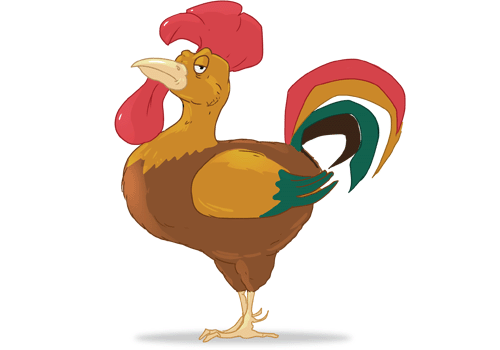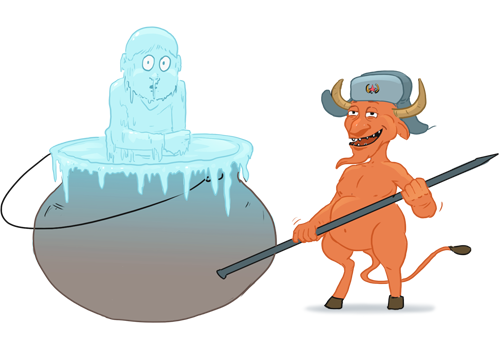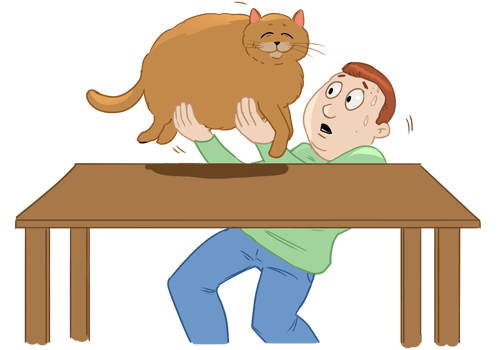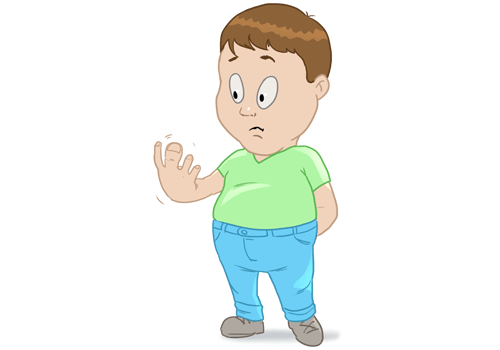Finnish
Suomen kieli
Suomen kieli
4,994,490 including 4,700,000 in Finland
Finland, EU
Sweden, Karelia (Russian Federation)
Sweden, Estonia, Norway, United States, Russian Federation, Canada


Finnish is a Finno-Ugric language. Together with the Samoyedic languages, Finno-Ugric languages form the Uralic language family. The following figure is a graphic representation of the historical development of the Uralic language family.
Historical development of the Uralic language family (source: http://www.regulytarsasag.hu/madartavlatbol citing: Finnougor Kalauz. edited by Martha Csepregi. Medicina Publishing Co, 2001.)
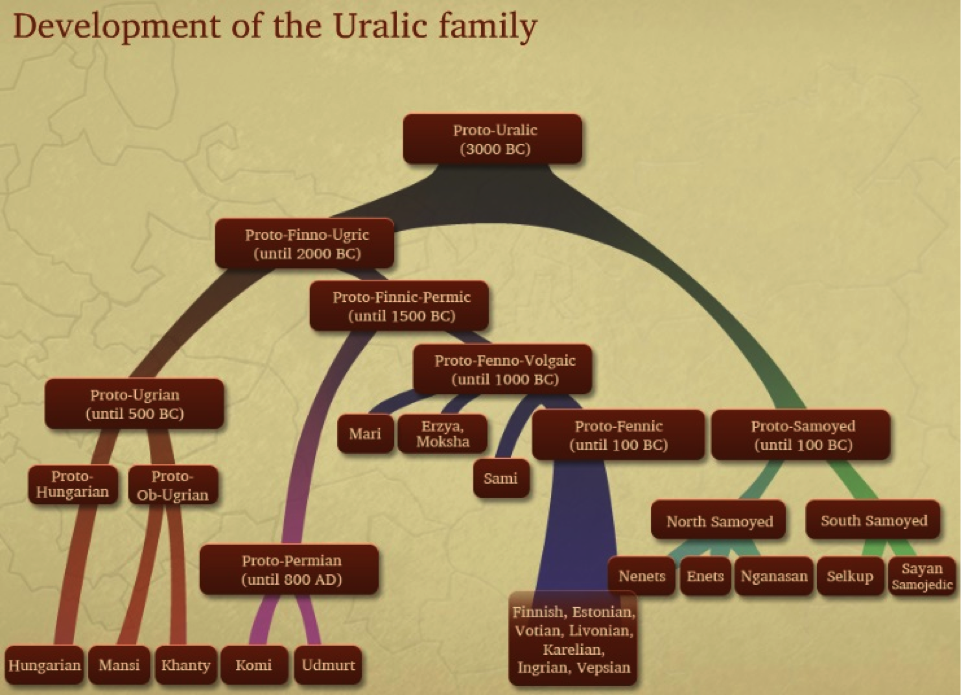
Many people suppose that Finnish and related languages are ‘Scandinavian’. In fact, Finnish is not genetically related to Swedish or Norwegian. The only major European language which has common ancestry with Finnish is Hungarian. To give a picture of how close this relationship is, Finnish is as closely related to Hungarian as English is to, let's say, Albanian or Russian. The most closely related to Finnish are other Baltic-Finnic languages: Estonian, Karelian, Vepsian, Livvi, Ingrian etc. Speakers of Finnish are able to understand Karelian and, to some degree, also Estonian. Finnish is one of the most powerful of the Finno-Ugric languages. It has official status in Finland and the EU and has almost 5 million speakers. Most of its sister languages are spoken in the Russian Federation. Many of these languages are threatened with extinction. The table below shows 15 related words in Finnish and other Finno-Ugric languages.
Related words in the Finno-Ugric language family.
| fi | ee | ve | sa | ma | er | ud | ko | kp | ha | ma | hu | |
|---|---|---|---|---|---|---|---|---|---|---|---|---|
| eye | silmä | silm | sil’m | čalbmi | шинча | сельме | син | син | син | сэм | сам | szem |
| tongue | kieli | keel | kel' | giella | йылме | кель | кыл | кыв | кыв | ньалəм | нēлым | nyelv |
| heart | sydän | süda | südäin | válbmu | шӱм | cедей | сюлэм | сьöлöм | сьöлöм | сăм | сым | szív |
| blood | veri | veri | veri | varra | вӱр | вeрь | вир | вир | вир | ўр | кēлп | vér |
| gall/bile | sappi | sapp | sap | sáhppi | шекш | сэпе | сэп | сöп | сöп | сып | восьрам | epe |
| ice | jää | jää | jä | jiekŋa | ий | эй | йö | йы | йи | йэк | яӈк | jég |
| cloud | pilvi | pilv | pil’v | balva | пыл | пeль | пилем | кымöp | пив | пăлəӈ | тул | felhő |
| river | joki | jõgi | jogi | johka | эҥep | ёв | шур | ю | ю | йŏхан | я | folyó |
| nest | pesä | pesa | peza | beassi | пыжаш | пизэ | kap | пoз | пoз | тыхəл | пити | fészek |
| one | yksi | üks | üks’ | okta | ик | вейке | одиг | öтік | öти | ит | акв | egy |
| two | kaksi | kaks | kaks’ | guokte | кoк | кaвтo | кык | кык | кык | кăтəн | кит | kettő |
| three | kolme | kolm | koume | golbma | кум | колмо | куинь | куим | куим | хулəм | хȳpӯм | három |
| four | neljä | neli | nel’ | njeallje | ныл | нилe | ньыль | нёль | нёль | ньăл | нилa | négy |
| five | viisi | viis | viž | vihtta | вич | вете | вить | вит | вит | вeт | ат | öt |
There are three main groups of dialects: the Northern, Eastern and Western dialects.
Dialects of Finnish
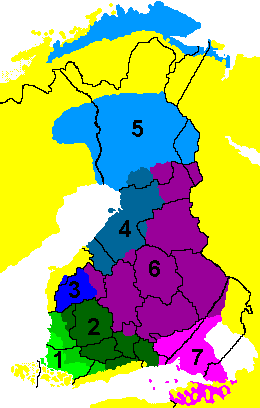
Source: Wikimedia Commons
Compared to other European languages, the dialectal divisions of Finnish are quite large. The main division between the dialects of Finnish is that between Eastern and Western dialects. Dialect differences mainly concern phonetics and phonology, but there are also some interesting lexical differences. For instance, the word for a boughs of birch used for sauna-bathing is vihta in Western and vasta in Eastern and Northern parts of Finland.
Distribution of vasta and vihta.
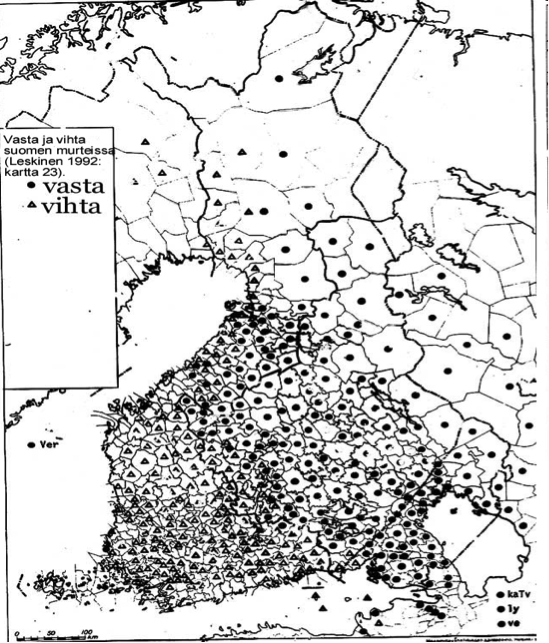
Finnish uses the basic Latin alphabet with three diacritics: ä, ö and å. Ä and ö are quite common, whereas å is only used in Swedish loanwords such as skål (‘cheers’, toast when drinking). Finnish makes a distinction between long and short sounds. This is quite important to remember since a mistake in vowel or consonant length can alter the meaning of a word. For example, one should be clear whether what they mean is recession (lama) or a llama (laama). There are significant differences in meaning in the following set of phonetically and visually very similar Finnish words:
The stress in Finnish is on the first syllable. It is a language where the basic rule is ‘say it the way you write it’. If you see a Finnish word in writing, you’ll most probably pronounce it correctly. Here is an online article about the most beautiful Finnish words.
Finnish is an agglutinative language where one morpheme (the smallest linguistic unit that conveys meaning) stands for one grammatical meaning. Forming words in an agglutinative language such as Finnish is like putting beads onto a string one by one. The Finnish vaimollenikin is translatable into English with use of several words and is ‘to my wife, too’:
vaimo-lle-ni-kin
In the General information-section at the beginning there is the longest Finnish word which is not a compound word – epäjärjestelmällistyttämättömyydelläänsäkäänköhän. It is also build up from morphemes put together according to the rules of agglutination. The word makes hardly any sense, though, and means more or less ‘not even by her lack of organization, do you suppose’.
Another interesting feature of Finnish is the number of grammatical cases. Depending on the approach, 14 to 17 cases are said to operate in Finnish. Six of them are locative cases: they convey the meaning of movement to a place, being in a place and moving away from a place. If a person wants to say they are in the house (talo), the form is talossa, whereby the -ssa-component means ‘in’. The suffix -sta is added to the root to express ‘out of’, whereas -on in taloon means ‘(in)to’. In Finnish it is important to distinguish between inner and outer locative cases. If something is an open space (such as a table or a roof), different case endings from the three mentioned above are used as Finnish makes a grammatical distinction between, for example, ‘into’ and ‘onto’. Katto means ‘roof’ in Finnish. Katolle is used to describe the action of coming onto the roof and katolta - descending from the roof:
Finnish locative cases

Finnish is famous for its inventory of onomatopoetic words. Words that represent sounds in Finnish differ according to who or what makes them.
to buzz
to hiss
to hum
to whine


